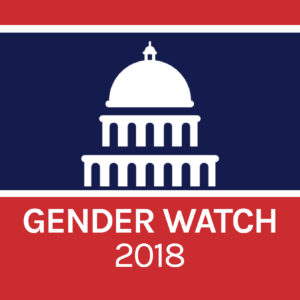Will 2018 Turn the Tide for Women Gubernatorial Candidates?
 From March to December 2018, the Barbara Lee Family Foundation (BLFF) and the Center for American Women and Politics (CAWP) partnered to offer Gender Watch 2018, which tracked, analyzed, and illuminated gender dynamics in the 2018 midterm elections. With the help of expert scholars and practitioners, Gender Watch 2018 furthered public understanding of how gender influences candidate strategy, voter engagement and expectations, media coverage, and electoral outcomes in campaigns. The blog below was written for Gender Watch 2018, as part of our collective effort to raise questions, suggest answers, and complicate popular discussions about gender’s role U.S. elections.
From March to December 2018, the Barbara Lee Family Foundation (BLFF) and the Center for American Women and Politics (CAWP) partnered to offer Gender Watch 2018, which tracked, analyzed, and illuminated gender dynamics in the 2018 midterm elections. With the help of expert scholars and practitioners, Gender Watch 2018 furthered public understanding of how gender influences candidate strategy, voter engagement and expectations, media coverage, and electoral outcomes in campaigns. The blog below was written for Gender Watch 2018, as part of our collective effort to raise questions, suggest answers, and complicate popular discussions about gender’s role U.S. elections.
Everybody is just so aggravated and frustrated with what’s going on…we are looking for a change. Maybe a woman is the person who’s going to bring a change. We’ve had the men all of these years… – Focus Group Participant
While this focus group participant could have easily been talking about 2018, this quote came from a participant in the very first focus groups held by the Barbara Lee Family Foundation (BLFF) almost twenty years ago. As the saying goes, the more things change, the more they stay the same.
BLFF has studied and published research about every woman’s gubernatorial race since 1998. We have shared our findings with hundreds of women candidates at all levels and across parties, giving women essential knowledge and tools to meet the challenges of campaigning. BLFF focuses on executive leadership because we know that having a woman as the decision maker, not just a decision maker, has the potential to transform her community.
However, BLFF research has consistently shown that when a woman is running to be the CEO of her state, voters need more evidence to believe she is prepared to do the job than they do for a man. The standards for women running for executive office are extremely high, which may account for the fact that increasing the number of women in the Governor’s Mansion has been a difficult feat. There are currently six women governors, and the most we’ve ever had serving at one time was nine. Over the course of U.S. history, only 39 women have ever served as their state’s governor. Compare that to over 2,300 men.
This year, with several more primaries still to go, a record number of women have already won their primaries for governor – 14, and counting. If the rest of the women running for governor this year win their primaries, 17 states will have at least one woman on the general election ballot for governor. And if a woman wins in each state, 34% of states will have a women governor, up from 12% of states now.
While it’s important to remember that some are running in races that are uphill battles, we shouldn’t let that detract from the significance of this moment. When BLFF opened its doors twenty years ago, only 16 women had ever served as their state’s governor.
Perhaps just as exciting as any records broken is the fact that, instead of trying to fit into a template of what a candidate should look like, women from all backgrounds are running as their authentic selves. Stacey Abrams (who would be the first black woman governor if elected) ties her own financial struggles to creating an economic plan for low-income Georgians. Christine Hallquist (who would be the first openly transgender governor if elected) uses her experience as CEO of Vermont Electric Coop to help show voters that she has executive leadership experience. Kristi Noem (who would be the first woman governor in South Dakota if elected) features the fact that she was named “Young Farmer of the Year” in one of her ads as evidence of her work ethic. The women running for governor this year are truly 360-degree candidates, using the whole of their experiences to connect with voters
A female state party official once told BLFF: “Men are used to being in charge. Running for office is something they take as an entitlement. Women need to show ‘I have the right.’” A woman candidate for governor shared: “For people to get comfortable seeing women in executive roles, they have to see women in executive roles. They have to see women run.” This year, women are claiming their right to run and, win or lose, they are changing what a governor looks likes – which counts as a success in our book.

